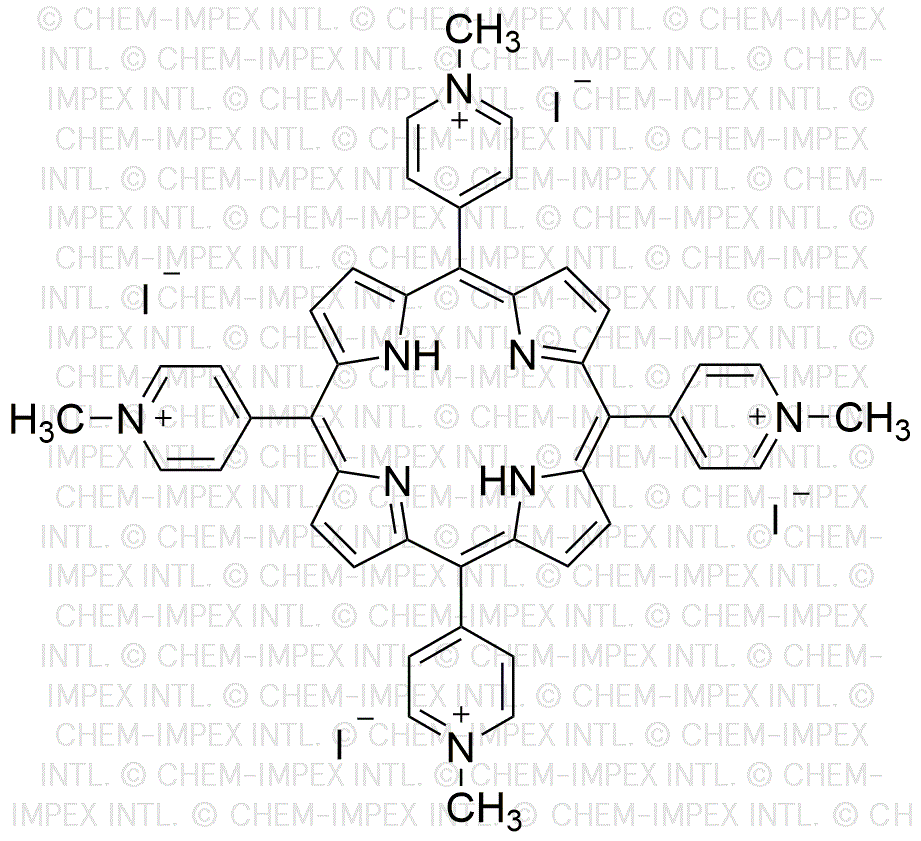5,10,15,20-(Tetra-N-methyl-4-pyridyl)porphyrin tetraiodide is widely utilized in research focused on:
- Photodynamic Therapy: This compound is effective in treating certain cancers by generating reactive oxygen species when exposed to light, making it a promising agent in targeted cancer therapies.
- Solar Energy Harvesting: Its unique properties allow it to be used in dye-sensitized solar cells, enhancing the efficiency of converting sunlight into electricity.
- Electrochemical Sensors: This chemical serves as a key component in developing sensitive sensors for detecting various analytes, including heavy metals and biomolecules, due to its electroactive nature.
- Biological Imaging: It is employed in imaging techniques to visualize cellular processes, aiding researchers in understanding complex biological systems and disease mechanisms.
- Antimicrobial Applications: The compound exhibits antimicrobial properties, making it useful in developing coatings and materials that prevent bacterial growth in medical devices and surfaces.
General Information
Properties
Safety and Regulations
Applications
5,10,15,20-(Tetra-N-methyl-4-pyridyl)porphyrin tetraiodide is widely utilized in research focused on:
- Photodynamic Therapy: This compound is effective in treating certain cancers by generating reactive oxygen species when exposed to light, making it a promising agent in targeted cancer therapies.
- Solar Energy Harvesting: Its unique properties allow it to be used in dye-sensitized solar cells, enhancing the efficiency of converting sunlight into electricity.
- Electrochemical Sensors: This chemical serves as a key component in developing sensitive sensors for detecting various analytes, including heavy metals and biomolecules, due to its electroactive nature.
- Biological Imaging: It is employed in imaging techniques to visualize cellular processes, aiding researchers in understanding complex biological systems and disease mechanisms.
- Antimicrobial Applications: The compound exhibits antimicrobial properties, making it useful in developing coatings and materials that prevent bacterial growth in medical devices and surfaces.
Documents
Safety Data Sheets (SDS)
The SDS provides comprehensive safety information on handling, storage, and disposal of the product.
Product Specification (PS)
The PS provides a comprehensive breakdown of the product’s properties, including chemical composition, physical state, purity, and storage requirements. It also details acceptable quality ranges and the product's intended applications.
Certificates of Analysis (COA)
Search for Certificates of Analysis (COA) by entering the products Lot Number. Lot and Batch Numbers can be found on a product’s label following the words ‘Lot’ or ‘Batch’.
*Catalog Number
*Lot Number
Certificates Of Origin (COO)
This COO confirms the country where the product was manufactured, and also details the materials and components used in it and whether it is derived from natural, synthetic, or other specific sources. This certificate may be required for customs, trade, and regulatory compliance.
*Catalog Number
*Lot Number
Safety Data Sheets (SDS)
The SDS provides comprehensive safety information on handling, storage, and disposal of the product.
DownloadProduct Specification (PS)
The PS provides a comprehensive breakdown of the product’s properties, including chemical composition, physical state, purity, and storage requirements. It also details acceptable quality ranges and the product's intended applications.
DownloadCertificates of Analysis (COA)
Search for Certificates of Analysis (COA) by entering the products Lot Number. Lot and Batch Numbers can be found on a product’s label following the words ‘Lot’ or ‘Batch’.
*Catalog Number
*Lot Number
Certificates Of Origin (COO)
This COO confirms the country where the product was manufactured, and also details the materials and components used in it and whether it is derived from natural, synthetic, or other specific sources. This certificate may be required for customs, trade, and regulatory compliance.


